An outlaw, a visionary, and the scourge of the establishment, the story of Nottingham’s legendary Robin Hood, who stole from the wealthy to help the poor, is well known across the world.
His adventures, which combine universal themes of adventure, benevolence, and defiance, have been passed down for decades, from medieval ballads to Hollywood blockbusters.
In other words, Robin Hood is perhaps one of the most well-known folk heroes in the world.
He has been the subject of ballads, literature, and films, substantiating as popular culture’s most memorable folk figure.
Over the span of nearly 700 years, the outlaw from Nottinghamshire who robs the rich to give to the poor has grown as one of the contemporary culture’s most lasting folk heroes–and one of its most diverse.
Was Robin Hood based on a true story?
Content
Because Hunter and other 19th-century historians unearthed so many different records associated with the name Robin Hood, most researchers came to accept that more than one individual most likely inspired the popular stories in the historical record.
Why did Robin Hood rob the wealthy?
Robin Hood is described as taking from the rich to give to the poor in order to defend the common man against tyranny.
What does Robin Hood stand for?
Robin Hood represents the spirit of the ordinary man rising up to tyranny and injustice. He represents hope. These are universal and ubiquitous ideas, which explain why he has a global following.
The Origins of Robin Hood
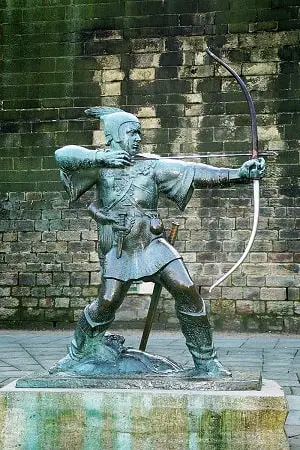
Robin Hood is a famous heroic outlaw who first appeared in English mythology and has since appeared in numerous literary pieces and entertainment.
He was a superb arch man, good at swords, and belonged to a noble family.
In recent reinterpretations, he is portrayed as fighting in the Crusades right before coming back to England to discover his land that was stolen by the Sheriff.
As per the earliest tales, he is one of the yeoman class’s members. Yeoman is a noun that refers to either a landowner or the middle ranks of laborers in an English royal or noble household.
The phrase was initially used in England in the mid-14th century. Likewise, Robin Hood is also traditionally represented in Lincoln green, robbing from the rich and giving to the needy.
In the Middle Ages, he was a prominent folk figure. The first known ballads about him date around the 15th century.
Over the years, there have been countless variants of this story, and it is still extensively shown in the cinema, in literary events, and on television.
One of the most well-known stories in English folklore is that of Robin Hood. The phrase “Robin Hood” is frequently used in popular culture to symbolize rebellion against authority with a heroic outlaw.
There have been various allusions to historical persons with similar titles presented as proof of his existence, out of which some date back to the 13th century.
The Tales and Ballads of Robin Hood
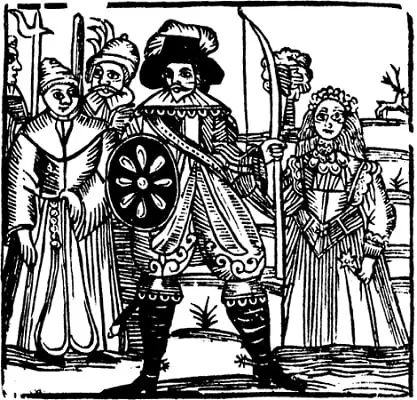
The earliest reference to “rhymes of Robin Hood”, written during the 1370s, comes from the poetry of Piers Plowman.
This is then supplemented shortly afterward, in Friar Daw’s Reply, by a mention of a later widespread adage, “many men speak of Robin Hood and never shot his bow.”
Mentions of Robin Hood are also included in a remark in Dives and Pauper (1405–1410); references to him are included as such- people were opting to listen to Robin hood’s tales than attending a mass.
Robin Hood is also featured in a renowned Lollard tract from the beginning of the 15th century along with other folk heroes including Bevis of Hampton, Guy of Warwick, and Sir Lybeaus.
The oldest known existing copies of the narrative songs that describe his life, however, come from the 2nd half of the 15th century or the 1st decade of the 16th century.
Robin Hood’s loyalty to the lesser strata, his reverence to the Virgin Mary, and concomitant special esteem for females.
His extraordinary ability as an archer, his anti-clericalism, and his especial hostility towards the Sheriff of Nottingham are all evident in these early stories.
Maid Marian and Friar Tuck appear, as do Little John, Much the Miller’s Son, and Will Scarlet (as Will “Scarlok” or “Scathelocke”).
The latter has been a part of the mythology since at least the late 15th century when he appears in a draft for a Robin Hood play.
In contemporary popular culture, Robin Hood is often portrayed as a compatriot and supporter of the late-12th-century monarch Richard the Lionheart.
Robin was driven to outlawry during Richard’s brother John’s misrule while Richard was gone on the Third Crusade.
This point of view became popular in the 16th century. The earliest ballads, however, do not support it. An earlier collection, a Gest of Robyn Hode, refers to the monarch as ‘Edward.’
While it has Robin Hood embracing the King’s pardon, he eventually denounces it and returns to the Greenwood.
Moreover, the earliest recorded ballad, Robin Hood and the Monk lends even less support to the image of Robin Hood as a loyal king supporter.
Robin Hood’s socioeconomic rank is clearly obvious in the early ballads: he is a yeoman.
While the precise meaning of this phrase evolved throughout time, it always referred to commoners, including free subordinates of an aristocrat and minor landholders.
In this case, the essence was “neither a knight, a peasant, or a husbonde, but anything in between.” In the 14th century, artisans (such as millers) were considered ‘yeomen.’
Beginning in the 16th century, there were to elevate Robin Hood to the nobility, such as in Richard Grafton’s Chronicle at Large.
Anthony Munday also addressed him as the Earl of Huntingdon in two exceedingly prominent plays at the end of the century, as he is still widely presented today.
May Day Games and Early Robin Hood Plays
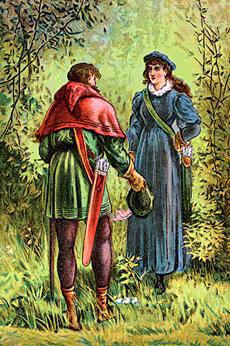
Robin Hood had become intertwined with May Day festivities by the early 15th century, with revelers dressed up as Robin or men of his band for the occasion.
This was not ubiquitous throughout England, but in some areas, it persisted until Elizabethan times.
It was also temporarily popular at court during Henry VIII’s reign. Robin was frequently assigned the position of a May King, reigning over games and processions.
But plays were also staged with the figures in the roles, sometimes at church ales, a way for churches to earn revenue.
Robin’s emotional attachment to Maid Marian (or Marion) appears to arise from his association with the May Games.
A “Robin and Marion” appeared in 13th-century French “pastourelles” (of which Jeu de Robin et Marion c. 1280 is a literary rendition). Robin Hood also held sway over the French May festivities.
In the interims of the latter’s alleged seduction by a series of knights, Robin and Marion tended to preside over a variety of quaint pastimes.
Robin and his allies must rescue Marion from the grasp of a “lustful knight” in the Jeu de Robin and Marion. This play is not to be mixed up with the English legends.
Despite the fact that Dobson and Taylor believe it is “very likely” that this French Robin’s name and features traveled to the English May Games and merged with the Robin Hood tale.
Robin and Marian were undoubtedly intertwined with May Day celebrations in England (as was Friar Tuck).
The Merry Adventures of Robin Hood
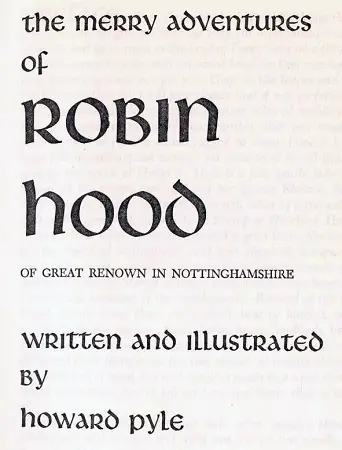
The Robin Hood fable was initially reinterpreted for children in the nineteenth century.
Children’s iterations of the garlands were released, as was a children’s edition of Ritson’s Robin Hood collection in 1820. Shortly after, children’s stories began to emerge.
It’s not that children haven’t encountered Robin Hood stories before, but this is the first time a Robin Hood book has been written expressly for them.
Howard Pyle, an American illustrator and author published The Merry Adventures of Robin Hood of Great Renown in Nottinghamshire in 1883.
Pyle arranged the classic Robin Hood songs as a series of events in the form of a logical story.
Pyle translated the late Middle English of the ballads into a child-friendly vernacular for his characters’ dialogue.
The work is remarkable for taking the concept of Robin Hood, which had grown in popularity throughout the nineteenth century, in a fresh direction that impacted later authors, illustrators, and filmmakers throughout the next century.
Robin Hood and Little John by Pierce Egan the Younger was a particularly prominent example of these children’s novels (1840).
Alexandre Dumas also reworked it into French in Le Prince des Voleurs (1872) and Robin Hood Le Proscrit (1874). Egan also created Robin Hood as a nobleman who was nurtured by the forester Gilbert Hood.
The plot follows Robin Hood when he becomes an outlaw following a confrontation with foresters, as well as during his many adventures and escapes from the law.
Each chapter follows Robin as he recruits Merry Men, opposes the government, and helps his fellow man.
Popular stories such as Little John overcoming Robin in a staff fight, Robin’s defeat at the hands of Friar Tuck, and his cooperation with Allan a Dale all appear.
In the end, King Richard the Lionheart pardons Robin and his men, and his troop is included in the King’s escort, much to the chagrin of the Sheriff of Nottingham.
Robin Hood in Popular Culture
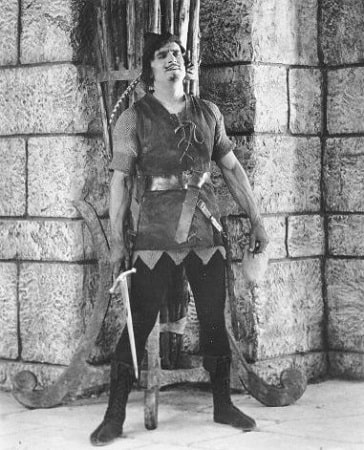
The traditional hero Robin Hood has been featured numerous times in popular modern works, in numerous variations, from books, video games, and movies to music, radio, and theatre.
Throughout the medieval period to contemporary times, Robin Hood has appeared in a variety of plays. The first recorded performance of a Robin Hood drama occurs in Exeter in 1426-27.
The earliest known text of a Robin Hood play, titled Robyn Hod and the Shryff off Notyngham, is from around 1475.
Anthony Munday’s The Downfall of Robert, Earle of Huntington and The Death of Robert, Earle of Huntingdon (1597–98) plays were possibly the most influence on the Robin Hood mythology as a whole.
Robin is depicted initially as a nobleman in these plays.
During the early modern period, more plays were written, including the anonymous Looke About You (1600) and Robin Hood and his Crew of Soldiers (1661).
Likewise, Robert Southey’s ‘Harold, or, The Castle of Morford’ was the first Robin Hood novel penned, albeit it was never published (1791). This is available in manuscript form in the Bodleian Library.
The anonymous Robin Hood: A Tale of the Olden Time (1819) was also the initially published Robin Hood novel, followed by Ivanhoe by Walter Scott a few months later.
As mentioned, Stephen Percy’s Tales of Robin Hood appears to be the first Robin Hood novel created exclusively for children (1840).
In 1865, John B. Marsh’s children’s book Robin Hood was published, as was a penny dreadful titled Little John and Will Scarlet (1865).
Howard Pyle’s next major novel, The Merry Adventures of Robin Hood, was published in 1883.
Similarly, the figure of Robin Hood has also been featured countless times in numerous television series, movies, and even parodies.
Conclusion
Robin Hood is a thief. That signifies he dwells outside of the reach of the law. Robin, on the other hand, is a law unto himself.
He calls himself the “King of the Greenwood,” referring to either Sherwood Forest in Nottinghamshire or Barnsdale in Yorkshire.
Robin is not your average criminal. He robs the rich and gives to the needy, as the old adage goes.
Robin Hood poses little threat to the poor. His adversaries are the wealthy and corrupt, particularly the Sheriff of Nottingham, as well as rotten apples in the Church.
The noble message behind this age-old tale of the criminal hero is one that will perhaps remain evergreen.
